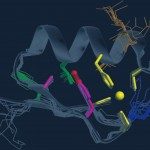Lien vers Pubmed [PMID] – 34400835
Lien DOI – 10.1038/s41564-021-00954-4
Nat Microbiol 2021 09; 6(9): 1188-1198
SARS-CoV-2 variants of interest and concern will continue to emerge for the duration of the COVID-19 pandemic. To map mutations in the receptor-binding domain (RBD) of the spike protein that affect binding to angiotensin-converting enzyme 2 (ACE2), the receptor for SARS-CoV-2, we applied in vitro evolution to affinity-mature the RBD. Multiple rounds of random mutagenic libraries of the RBD were sorted against decreasing concentrations of ACE2, resulting in the selection of higher affinity RBD binders. We found that mutations present in more transmissible viruses (S477N, E484K and N501Y) were preferentially selected in our high-throughput screen. Evolved RBD mutants include prominently the amino acid substitutions found in the RBDs of B.1.620, B.1.1.7 (Alpha), B1.351 (Beta) and P.1 (Gamma) variants. Moreover, the incidence of RBD mutations in the population as presented in the GISAID database (April 2021) is positively correlated with increased binding affinity to ACE2. Further in vitro evolution increased binding by 1,000-fold and identified mutations that may be more infectious if they evolve in the circulating viral population, for example, Q498R is epistatic to N501Y. We show that our high-affinity variant RBD-62 can be used as a drug to inhibit infection with SARS-CoV-2 and variants Alpha, Beta and Gamma in vitro. In a model of SARS-CoV-2 challenge in hamster, RBD-62 significantly reduced clinical disease when administered before or after infection. A 2.9 Å cryo-electron microscopy structure of the high-affinity complex of RBD-62 and ACE2, including all rapidly spreading mutations, provides a structural basis for future drug and vaccine development and for in silico evaluation of known antibodies.


